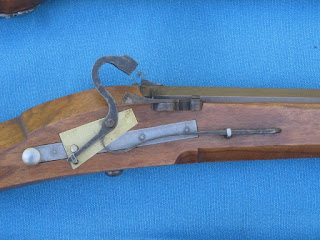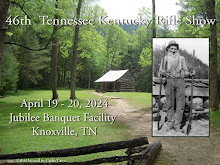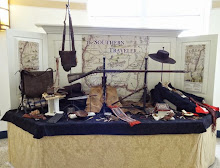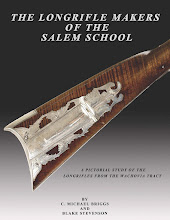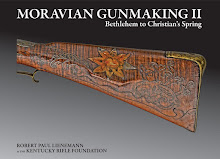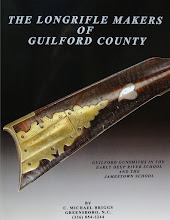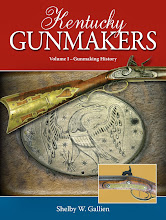Thursday, May 31, 2018
From the Pages of Flintlock Magazine: George Seidenschwarz by Robert Weil
George Seidenschwarz is still a well kept secret. This master gun smith who reposes in
Lafayette, Tenn has made some of our finest contemporary arms. I have seen roughly six rifles and two
pistols, each having all handmade locks and triggers and they are all
superb. His overall finish and attention
to detail is just amazing. Like most
European arms the metal and wood seem to melt into one another. The locks and triggers
too have a finish akin to satin. There is a particular beauty to his stock
architecture as well. Difficult to describe without actually having it in hand,
it has an oval shape, often higher than wide.
Very unique.
I believe there will be a few of George's guns on display in
this years show. Look for them.
Labels:
Flintlock Magazine,
George Seidenschwarz
Wednesday, May 30, 2018
From the Pages of Flintlock Magazine: The Richard Butler Tomahawk By Gordon Barlow
In 1750, Virginia claimed the land around Fort Pitt citing
the boundaries established in the charter presented to the colony by the mother
country. Virginia claimed that the western boundary of Pennsylvania stopped
east present day Pittsburgh. The Land charter issues by the King to wealthy
Virginians support this claim. The Ohio Company formed in Virginia paid large
sums of money to frontiers men to explore the Ohio River and the surrounding
land. In 1753, Governor Dinwiddie of Virginia sent George Washington to meet
with the French to represent Virginia’s claim to the land along the Allegany
and Ohio Rivers. He sent the Virginia Militia to build the first fort at the
Forks of the Ohio, based on a recommendation from George Washington. The
Virginia Militia were present during most attempts to remove the French forces
from the region. First, the Virginia Militia was with Colonel Washington at
Fort Necessity. Then, they served under General Braddock and later, with General
Forbes and Colonel Bouquet. It was only natural that the Virginia Militia was
placed in charge of Fort Pitt after there excellent performance with the Forbes
Expedition. The year was 1764. Richard Butler came to America when his
father Thomas Butler moved the family from Killkenny, Ireland to Carlisle, PA.,
in 1743. Thomas Butler was a gunsmith of the highest order. His shop still
stands in Carlisle, PA, today. Richard trained as a gunsmith under his father.
In 1764, he went to Fort Pitt at the Forks of the Ohio while serving with
Colonel Henry Bouquet during his campaign to defeat the Shawnee and Delaware
during Pontiac’s Uprising. Ensign Richard Butler was an armorer with Colonel
Bouquet.
In 1765, Richard signed on as an armorer at Fort Pitt. His daybook
from Fort Pitt survived and is now owned by the Carnegie Institute in
Pittsburgh, Pa. The daybook list many pipe tomahawks and axes as being made by
Richard Butler. This Pipe Tomahawk with an engraved and silver inlaid forged
blade signed “Richard Butler”, with a silver screw off bowel, silver end cap
engraved Lt J. Maclellan, and a maple haft with a silver band which also
includes the magnificent Shawnee dyed porcupine quillwork is an example of the
work he made while an armorer at Fort Pitt.
In 1772, Richard Butler was a commissioned as a Captain in
the Pennsylvania Militia. Within a few years, Richard and his brother William
formed a company north of Fort Pitt in the town already known at Pittsburgh. As
partners they provide gunsmithing, blacksmithing and trading services. Together
they worked in the fur trade. They specialized in providing supplies and goods
to the region. There business prospered as their relations with the Shawnee
Indians from along the Scioto and Ohio Rivers developed. Not only was he a
successful businessman, Richard was highly trusted by the Indians in the
region. In 1775, Richard resigned as Captain of the Pennsylvania Militia and
accepted a Pennsylvania commission as Agent of Indian Affairs for the
middle-western region of Pennsylvania. Richard strengthened relations with the
Shawnee and with the Delaware whereby he signed a Treaty of Neutrality with
them. Peace would not last.
In April, 1776 Richard Butler was commissioned as a Major in
the Continental Army in the 8th Pennsylvania Regiment. He fought with the
Riflemen at Saratoga. He commanded the 9Th Pennsylvania Regiment at Stoney
Point and was Colonel of the 5th Pennsylvania Regiment at Yorktown. Richard
Butler continued to serve his country after the War for Independence. He was
appointed Major General and was second in command under General Arthur St.
Clair on an ill-fated campaign against the Ohio Indians in 1791. On November 4,
1791 Richard Butler was killed at the battle on the Miami River in Ohio. The
battle was a disastrous defeat for the American Army.
The silver end cap on the haft is engraved Lt. Maclellan. Lt
John McClelland was a First Lieutenant of Company D of Thompson’s Battalion of
Pennsylvania Riflemen. The D Company of riflemen was raised in Cumberland County,
Pennsylvania. Riflemen were required to carry tomahawks as a secondary weapon
since their longrifles were not equipped to receive fixed bayonets.
The riflemen recruited on the frontier of Virginia and
Pennsylvania were the first units authorized by the Continental Congress in
1775. They were immediately ordered to join General Washington’s Army for the
siege of Boston. The riflemen though undisciplined and ill suited to siege
warfare perform exceedingly well as undisciplined soldiers.
After General Anthony Wayne had played a key role in the
capture of Ft Ticonderoga, he convinced General Washington to appoint him
commander of 1,100 men to attach the British forces at Quebec. General Wayne’s
Army included three companies of riflemen under the command of Captain Daniel
Morgan of Virginia. One of these companies was Company D of Thompson’s
Battalion of Pennsylvania Riflemen of which Lt John McClelland was an officer.
In September, 1775 General Wayne’s men including three
companies of riflemen under Captain Daniel Morgan of Virginia sailed up the
Kennebec River to the interior of Maine. The weather was extremely cold even
for that region. The wilderness river and bitter cold from the early onset of
winter exhausted the troops. The overland trip through Maine toward Quebec was
extremely fatiguing. Doctor Isaac Senter, a physician from Rhode Island, joined
the expedition as it’s surgeon. On October 31, 1775, Dr Senter made this entry
in his journal in the northern wilderness of Maine near the Canadian border:
“At this encampment was Lt McCleland of Morgan’s Company,
almost expiring with a violent peripneumonia. Necessaries were distributed as
much as possible, with two lads of the company in charge of him. Nor was this
poor fellow the only one sick upon the river.”
Lt John McClelland died on November 3, 1775 at that encampment. No doubt
his soldiers took his rifle and tomahawk on to the Battle of Quebec. When the
Continental Army meet the British at Quebec the Continental Forces was reduced
to less than 700 men. Captain Morgan and most of his riflemen were captured.
The Richard Butler Tomahawk was in the collection at the Warwick Castle in
England from colonial times until the mid 1990’s. It is safe to assume that
this wonderful artifact made it’s way to the Battle of Quebec, probably in the
hands of Lt John Macclellan’s brother, where it was captured and taken back to
England as a souvenir of war.
Special thanks to David Kliener, Bloomingburg, New York for
facilitating the opportunity for me to own this magnificent and important pipe
tomahawk. Also I want to thank the following scholars of the American Longrifle
for their important research provided to me relating to the Richard Butler Pipe
Tomahawk.
Rick Rosenberger, Pittsburgh, Pa.
Walter O’Connor, Warminster, Pa.
Stephen Hench, Lancaster, Pa.
Flintlock Magazine 2002 Volume 5 Number 1.
Labels:
Article,
Flintlock Magazine,
Tomahawk
Tuesday, May 29, 2018
From the Pages of Flintlock Magazine: David Wright and Fess Parker
To all my friends who love history and old frontier
movies. Time for a little shinin'!
Look at this, will you... just proves that if you wait long enough, anything
can come true. Me an ole Davy! By
Gar! Eat your heart out, all you 50’s Crockett boys. (Son! He's tall, isn't he?)
“Give 'em what fer, Davy." Georgy Russell's last words
at the Alamo. Glorious times.
David Wright
Flintlock Magazine 2002 Volume 5 Number 1.
Labels:
David Wright,
Flintlock Magazine
Monday, May 28, 2018
Memorial Day 2018
Thank you to all the men and women who lost their lives in the service of our country. We also thank their families.
The gravestones at Arlington National Cemetery are decorated by U.S. flags on Memorial Day weekend.
Image from here.
Friday, May 25, 2018
Thursday, May 24, 2018
"Moravian Gunmaking II - Bethlehem to Christian's Spring" by Robert Lienemann
Robert Lienemann and team
extend their previous pioneering study focusing on the gunshops at Bethlehem
and Christian’s Spring 1750-1790
224 pages with high quality photos - most in color, plus sketches and critical dimensions
Great reference for collectors, builders, restorers, and historians
Our
first book – Moravian Gun Making of the American Revolution included a brief history plus twelve wonderful
arms - rifles, smooth rifles, a swivel breech rifle, fowler and pistol from
various communities over many years, and allowed for a broad introduction to
Moravian gunmaking.
In contrast, Moravian
Gunmaking II focuses narrowly on arms
that were – or may have been made at the gunshop set up at Bethlehem in 1750,
which then moved ca 1759 – 1763 to Christian’s Spring – a small community where
young men and boys learned trades in support of their mission work. The gunshop there was very active during several
wars, but it and the broader vocational effort had faded by 1790.
An introduction is
provided to Moravian gunmaking, and the two gunshops along with typical tools,
materials and techniques are discussed.
This is followed by a brief summary of who was where, their roles and
what was happening in the world around them for each year 1750 through
1790. Then come chapters introducing the
arms, their art and history.
Many individuals,
families and museums have shared their collections, and new color photographs
were taken of all available pieces.
Wherever possible, key dimensions are given and construction details
reviewed and compared. This should be of
value to study, stocking and restoration, while still being respectful of those
who have shared their treasures with us. Twenty two long guns, a pistol and a pair of
pistols are presented in this book, often with eight to fifteen or more photos
each –
A
ca 1725 rifle and ca 1750 pistol stocked in Germany, to show what Albrecht,
Beck and others might have learned as apprentices and journeymen there, and
what they may have taught their young apprentices here
The
keystone Edward Marshall rifle, often attributed to Andreas Albrecht, presented
in color with comments from John Bivins and the author
Smooth
rifle that seems a twin to the Marshall rifle, with comments from a prior
curator
Rifle
attributed to Albrecht, known as rifle # 43 in Shumway’s Rifles of Colonial America, Vol I
Photos
and notes regarding a “lost” rifle that might have come from these shops
1773
Christian Oerter rifle, known only from a letter in Oerter’s hand describing
his work
Oerter
rifle signed and dated 1774 with wood patchbox and wire inlay, now restored
“New”
1774 Oerter rifle, recently discovered in Europe in near new condition, broken
down for careful review inside and out, with nearly 50 photos, many dimensions
and details
1774
Oerter rifle for Coykendall, restored and now in color with review
Extensively
decorated “new” 1774 Oerter rifle for Hankinson with review
Hankinson thumb piece and wire inlay
Aaron Hankinson portrait
Aaron Hankinson gravestone
Short
description of another surviving 1774 Oerter rifle without photos
Signed
and dated 1774 Oerter barrel in probable restock
1775
Oerter smooth rifle at Windsor Castle with modifications by Durs Egg (Shumway’s
# 44), also in near new condition, now in color with detailed review
1775
Oerter rifle stolen from Valley Forge (Shumway’s # 45), with additional black
and white photos which clearly show the profile, details and wire inlay
A
long fowler attributed to the Christian’s Spring gun shop
Fine
pair of brass barreled pistols signed W Henry, Jr. at Nazareth, now in color
·
Six additional rifles or
smooth rifles that seem related to these gunshops are presented in color with
notes. Two are covered extensively, while
four are mentioned briefly with two or three photos each.
We also learn about the musical
abilities of these individuals, and their formal teaching roles. Their additional artistic talents and the
closed nature of the two communities may have allowed and encouraged greater
artistic expression at the bench.
This focus on one trade at
two locations allows a more in-depth study of how the gunmaking trade operated,
and much of the understanding of the trade can be projected to other men and
shops in this period.
Here is a small part of the story of the birth and
development of the Kentucky rifle, and of our art and history expressed upon
this common tool.
The book is now available on the Kentucky Rifle Foundation's website under the Store. You can order online with PayPal, credit card or with a check by mail. The book sells for $85.00 plus $8.95 S&H. Proceeds support the KRF mission of broadening the knowledge and appreciation of the American longrifle. Descriptions of all KRF books, CDs, and ordering information can be found at: kentuckyriflefoundation.org (or send check or money order to: Kentucky Rifle Foundation, 844 Round Hill Rd, Winchester, VA 22602)
Copy and photos supplied by by Robert Lienemann.
Copy and photos supplied by by Robert Lienemann.
Subscribe to:
Posts (Atom)
























